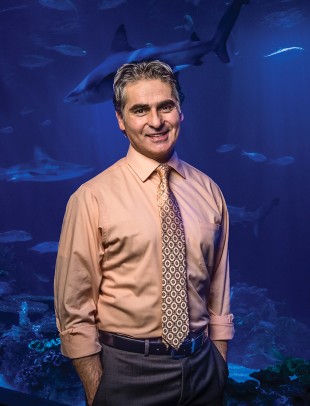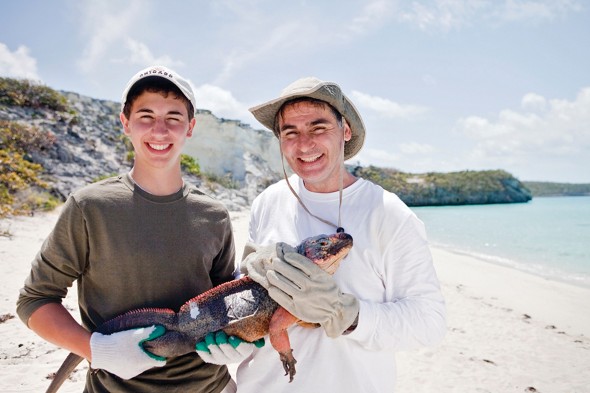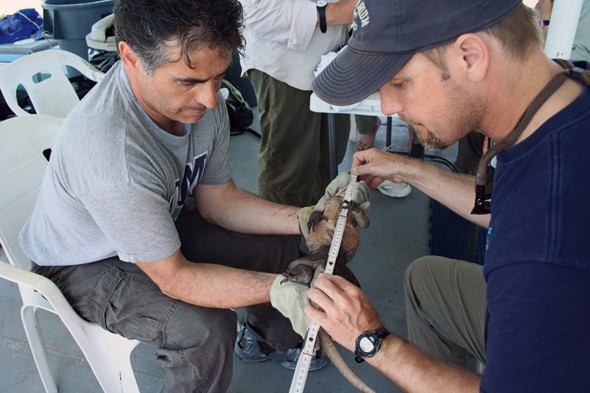Shedd Aquarium executive a go-getter grad

“In terms of species, we’ve got 1,500, which makes us the top aquarium in the world,” says Mike Delfini, Shedd Aquarium’s chief operating officer and executive vice president. Photo: John Boehm
By Jonathan Black
Years ago, when Mike Delfini was just beginning his career as a graphic designer at the Field Museum, he’d pack his lunch and walk across what is now the Museum Campus to Shedd Aquarium.
There, the recent UIC art grad would relax and decompress in the cool dark that surrounded the big fish tank of the Caribbean Reef. Though his surname, Delfini, means “dolphins” in Italian, he had no plans to spend anything more than lunch among the world’s marine animals.
Today, Delfini does more than just visit. As the Shedd’s chief operating officer and executive vice president, he coordinates just about everything that makes it one of the world’s great aquariums. Delfini oversees the Shedd’s research and education outreach programs and plays a major role in designing its branding and strategic marketing. He is responsible for the special exhibits that help draw close to 2 million visitors to the site annually.
Delfini led the management team for the Oceanarium Reimagined project and helped guide two major capital campaigns: the $60 million Fund for the Shedd and the $100 million Next Wave campaign. Before he became COO, he served 10 years as vice president for planning and design.
How do you go from working as a graphic artist to becoming second-in-command at one of Chicago’s great cultural institutions?
“I get that question a lot,” says Delfini, who earned his BFA in 1985. “It’s all about going from one circle in scope to the next circle. It’s all about looking for opportunity.
“When young folks come to me looking for work today, it can be a tough conversation. They’ll say, ‘How about you give me the job and the title and the salary, and I’ll prove I can do it.’ I tell them, ‘How about you prove to me you can do it, and then I’ll give you the job and the title and the salary.’
“That’s how I moved through my career.”
Delfini says he got off to a running start, thanks to UIC. A transfer student from College of DuPage, he selected UIC because he wanted to be near opportunities for work in the city. But getting admitted was no cakewalk.
“It wasn’t about grades,” he says. “You had to show your work, and the curriculum was very different than DuPage’s, which focused on illustration and drawing — it was called commercial art there. DuPage didn’t even use the term graphic design.”
But once he was admitted, “UIC was a phenomenal experience,” Delfini says. “I loved the professors, many of whom had working studios and real clients and real jobs. There were terrific summer internships. I’d always loved museums and cultural institutions, and they encouraged us to seek out work as designers there.”

Delfini and his son, Paolo spent 10 days at the Shedd’s research vessel in the Bahamas. Photo: Shedd Aquarium
After graduating from UIC, Delfini toted his portfolio all over the city, from the Shedd to the Art Institute to the Museum of Science and Industry, until he landed a job at the Field Museum.
“If it wasn’t for the Oceanarium project, I’d probably still be there,” he says.
It was the late 1980s, and the Shedd was almost 60 years old. The 90,000-gallon central rotunda tank — the Caribbean Reef, where Delfini enjoyed his quiet lunch hours — remained the aquarium’s major draw, but much of the remaining building housed “dry” exhibits, mounted displays and artifacts. Ted Beattie, the Shedd’s longtime president and CEO, looked around when he first arrived in 1994 and asked, “Where are all the animals?”
The Oceanarium was designed to meet that need — a $47.2 million addition built on 1.8 acres of landfill and the first building expansion in Shedd’s history.
What passersbys on Lake Shore Drive saw as a vast construction site, Delfini viewed as a job opportunity. He marched into the aquarium, figuring it would “need some help,” and got hired.
As he anticipated, the Shedd “exploded.” Every department, from public relations to marketing and membership, soon required new staff.
True to the advice he dispenses today, Delfini took on additional responsibilities without a title upgrade or salary increase. “People said, ‘Hey, you’re doing great work; how would you like the job as director of this or that?’” he recalls.
“It was all about process and planning. I’m not an expert in conservation and education, but I could help every department deliver its goals.”
Beattie has been especially grateful to have Delfini as his second-in-command.
“Mike has a unique understanding of the essential role planning plays in an organization,” Beattie says. “He’s very creative and cares about the people he works with. He brings people along with him through the process — start to finish — and a project isn’t finished until he’s finished.”
Delfini loves everything about the Shedd. He’s particularly proud of the special exhibits, which kicked off in 1995 with “White Alligator: Secret of the Swamp.”
“Since then, we’ve had a phenomenal program that’s covered all kinds of species — seahorses, crabs, frogs, lizards, you name it,” he says. “They’re compact exhibits designed to be seen in 20 minutes or so. And we’ve had terrific partnerships.”
There’s plenty of competition, including aquariums in Monterey, Baltimore and Atlanta, but in 2012 the Shedd was ranked the nation’s No. 1 aquarium in attendance.
“In terms of species,” Delfini says, “we’ve got 1,500, which makes us the top aquarium in the world. We’re also the oldest and located in a historic building. So, I guess by reputation, we’re No. 1.”
That said, Delfini is anything but complacent. The Shedd is constantly evaluating every aspect of the visitor experience, from food and parking to how guests connect with the animals. Observation and surveys help, as do less traditional techniques.
Researchers from IDEO, an international design and consulting firm, “literally got into a van with a California family that was coming to the Shedd and followed them all the way,” Delfini says. When the family stopped at a McDonald’s beforehand, for example, the researchers asked the kids why, to which they responded: “because museum food is crummy!” That comment inspired Delfini to update the Shedd café and restaurant, as well as think about the ways families visit museums today.
“Kids lead the way now,” he says. “They’re the decision makers.”
Expanding on that principle, the Shedd is in the midst of constructing a new learning lab that will be staffed entirely by teenagers. Teens also will be hired to work in the Horticulture Department and explain the gardens outside the Shedd to the public.
Delfini himself has two teenagers and is delighted that both seem to be following in dad’s footsteps, if on different paths. One son wants to be an urban planner (“he’s heard me talk about it my whole life”), while the other wants to be a “conservation guy” and work with animals.
“They grew up with the Shedd, and maybe they’ll build their [own careers] here, which would be great.”
Unlike the Field Museum, which is struggling under a mountain of debt, the Shedd is in solid financial shape. Of its $56 million operating budget, Delfini says, 85 percent is “earned” from admission revenue, 5 percent comes from state money, and the remaining 10 percent comes from fundraising.
He’s guarded when asked about the death of an animal trainer at Florida’s SeaWorld and the film “Blackfish,” which raises the troubling question of whether certain animals, such as killer whales, should be in captivity at all.
“I haven’t seen the film and can’t comment on it,” Delfini says. “All I can tell you is: We make sure our animals are safe, and that our public and staff are safe. There’s always some risk with wild animals, but clearly, we believe that having these animals here and on display and able to connect with our audience is the way to inspire folks and make a difference. We’re here to connect with animals — that’s in our mission.”
Delfini’s plans for the Shedd are as diverse as the aquarium itself.
Both the Wild Reef and Amazon exhibits are “getting up there in years. It may be time to re-imagine them for redevelopment,” he says.
More immediately, he’s focused on the Great Lakes and expanding an interactive exhibit on lake sturgeons into what he calls a “bolder Great Lakes program.”
“There are so many animals to display and teach about,” he says.

